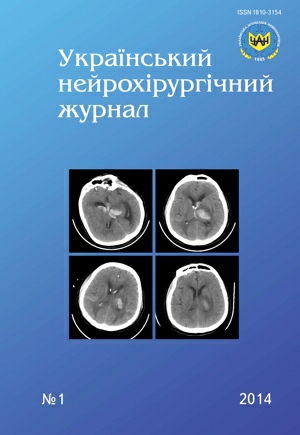Medical glue Sulfacrylate
DOI:
https://doi.org/10.25305/unj.51538Keywords:
medical glue, SulfacrylateAbstract
Medical glue Sulfacrylate was designed for bonding different tissues (skin, mucosa, meninges, lungs, kidneys, bone grafts etc.) in vivo, for seam sealing, hemostasis and anastomosis performing in all fields of surgery.
Complete absorption of the glue takes 30–45 days from it’s application on living tissue.
Sulfacrylate has bactericidal activity against surgical infectors: E. coli, St. aureus, Proteus, Ps. aeruginosa.
Sulfacrylate’s biocompatibility, non-toxicity, ability to provide effective hemostasis and wound surface sealing, and bactericidal can reduce terms of treatment and achieve the desired results in different clinical situations.
References
1. Tolstikov AG, Tolstikov GA, Vorobiova AI, Marchenko VT, Krivoshapkin AL, inventors; GK Boreskov Institute of Catalysis, Novosibirsk, Russia, assignee. The medical glue. Russia Patent 2156140A. 2000 September 20.
2. Marchenko VT, Shkurupij VA. Morfologicheskiye osobennosti reparativnoy regeneratsii organov i tkaney pri ispol'zovanii «Sul'fakrilata» novogo pokoleniya [Morphological features of reparative regeneration of organs and tissues using new "Sulfacrylate"]. Bul Experim biologii I Meditsiny. 2004;2:231-6. Russian.
3. Marchenko VT, Prutovykh NN, Tolstikov GA, Tolstikov AG. Meditsinskiy kley “Sul'fakrilat”. Antibakterial'naya protivovospalitel'naya kleyevaya kompozitsiya: rukovodstvo dlya primeneniya v khirurgicheskikh otraslyakh [Medical glue "Sulfacrylate”. Antibacterial anti-inflammatory adhesive composition: Guidelines for the surgical fields]. Novosibirsk; 2013. Russian.
4. Marchenko VT, Tolstikov GA, Tolstikov AG, Plechev VR, Leplialin GV, Maliksetov VR. Primeneniye antibakterial'noy protivovospalitel'noy kleyevoy kompozitsii “Sul'fakrilat” v detskoy khirurgii [The use of antibacterial antiadhesive composition "Sulfacrylate" in pediatric surgery]. In: Abstract Book of VI conference “Topical issues of modern medicine”; 1996; Novosibirsk, Russia. Novosibirsk, 1996. p.126-7. Russian.
5. Krivoshapkin AL, Panarin VA, Melidi EG, Orlov KIu, Berestov VV. Ispol'zovaniye meditsinskogo kleya “Sul'fakrilat” v sosudistoy neyrokhirurgii [Use of medical glue "Sulfacrylate" in vascular neurosurgery]. [Internet] In: Abstract Book of the 1st conf. "The use of medical glue “Sulfacrylate" in different fields of medicine”; 2011 September 9; Bijsk, Russia. Bijsk, 2011. Russian. Available at: http://sulfakrilat.ru/lib/Presentation_Neuro.pdf
6. Melidi EG, Krivoshapkin AL, Semin PA, Kanygin VV. Opyt maloinvazivnykh khirurgicheskikh vmeshatel'stv pri sosudistykh mal'formatsiyakh golovnogo mozga [Experience in minimally invasive surgical procedures for vascular malformations of the brain]. Neurokhirurgia. 2003;2:13-17. Russian.
7. Krivoshapkin AL, Melidi EG, Berezin IuA, Tolstikov AG, inventiors; Novosibirsk Research Institute of Traumatology and Orthopedics, Novosibirsk, Russia, assignee. The method of surgical treatment of cerebral arteriovenous malformations. Russia Patent 2240831A. 2004 November 27.
8. Yakobenko LM, Litvak SO. Vykorystannya kleya medychnoho Sulfakrylat dlya plastyky ta hermetyzatsiyi tverdoyi mozkovoyi obolonky ta dodatkovoyi fiksatsiyi frahmenta kistky pislya kraniotomiyi. Vidhuk [Use of Sulfakrylate medical glue for plastics and dura mater sealing and additional bone piece fixation piece after craniotomy. Review.] [Internet]. Sulfacrylate — Medical Innovations. Ukrainian. Available at: http://sulfakrilat.com.ua/pdf/1.pdf
9. Bajkalov AA. Ispol'zovaniye kleya meditsinskogo Sul'fakrilat pri prikleivanii loskutkov tverdoy mozgovoy obolochki pri likvornykh svishchakh. Otzyv [Use of medical glue Sulfacrylate for dural flaps gluing at liquor fistulas. Review.] [Internet]. Sulfacrylate — Medical Innovations. Russian. Available at: http://sulfakrilat.com.ua/pdf/7.jpg
Downloads
Published
How to Cite
Issue
Section
License
Copyright (c) 2014 Oksana Poltoratskaya

This work is licensed under a Creative Commons Attribution 4.0 International License.
Ukrainian Neurosurgical Journal abides by the CREATIVE COMMONS copyright rights and permissions for open access journals.
Authors, who are published in this Journal, agree to the following conditions:
1. The authors reserve the right to authorship of the work and pass the first publication right of this work to the Journal under the terms of Creative Commons Attribution License, which allows others to freely distribute the published research with the obligatory reference to the authors of the original work and the first publication of the work in this Journal.
2. The authors have the right to conclude separate supplement agreements that relate to non-exclusive work distribution in the form of which it has been published by the Journal (for example, to upload the work to the online storage of the Journal or publish it as part of a monograph), provided that the reference to the first publication of the work in this Journal is included.









